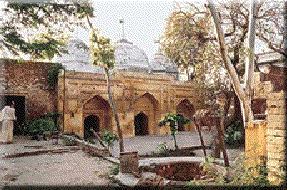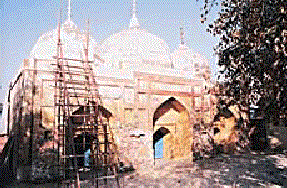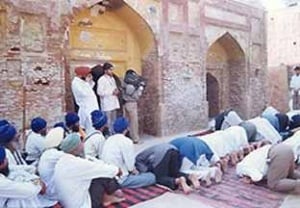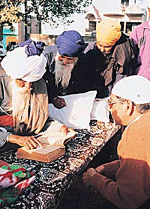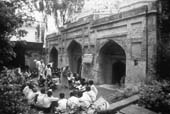Guru ki maseet
When Hargobind Sahib Ji was anointed the sixth guru of the Sikhs he asked Baba Buddha Ji, an eminent Sikh to bring forth two swords. These Guru Sahib Ji put on as symbols of spiritual (miri) and temporal (piri) authority. Guru Hargobind Sahib Ji is known as ‘miri piri thay malik’, "Lord of miri piri".
Guru Hargobind Sahib Ji built the Akal Takhat, the throne of the Almighty, opposite the Harmindar Sahib (Golden temple), again this was a sign of bringing together spiritual and temporal powers.
In December, 1634 Guru Hargobind Sahib fought a fierce battle against Mughal forces near the river Beas, although heavily outnumbered, the Guru was victorious. Guru Sahib decided to stay for a while, and soon a settlement grew up at this location. The settlement expanded into a town which became known as Sri Hargobindpur (-pur, being a suffix for "place of"). As the conflict with the Mughals was intensifying the towns defences were fortified. In fact, these fortifications were so solid that the original city walls and many buildings within are still visible today throughout Sri Hargobindpur in Gurdaspur district, Punjab.
Residents of all faiths flocked to the Guru and perceived themselves as heirs to the sixth Guru’s desire to found a secure and secular home on the banks of the Beas. The Sikhs built themselves a Gurdwara (Sikh temple) but the local Muslims did not have the capacity to build themselves a place of worship. They came to the Guru and asked him for help. The All Knowing Guru was equally comfortable with Muslim faqirs and Hindu sadhus and saw all people with one benevolent gaze. The Guru ordered his Sikhs to start construction of a "maseet" (mosque). The maseet was duly completed and handed over to the Muslims.
With the turmoil of the partitioning of India in 1947, the mosque fell into a state of neglect and disrepair. In time the care of the masset fell into the hands of a group a Nihang Singhs who installed the Sikh scriptures Guru Granth Sahib. For many years, the mosque was maintained by the Nihangs.
In February 8th, 2003 a “Memorandum of Understanding” (MoU) was signed by Baba Kirtan Singh the chief of the Nihangs, the Sikh caretakers of the mosque, and the Punjab Waqf Board. It was Baba Kirtan Singhs desire that Muslims perform their prayers at the mosque which was gifted to them. As per the wishes of Baba Kirtan Singh, five saplings were planted in the names of the Sikh Gurus. Dr Mohammad Rizwanul Haque, Punjab Waqf Board Administrator, described the MoU as an international event which would pave the way for strengthening communal harmony in the country.
The mosque was in a state of disrepair and work began on its restoration by a group of Sikhs and Muslims in a unique manifestation of India's multi-religious society. Sikhs offered their labour, Muslim masons repaired the walls and an all-woman team of restorers led by Ms Gurmeet Kaur Rai lent its expertise. The entire village, and even those from the surrounding areas, answered Rai's call for clearing the earth around the shrine. Hundreds of school children and Nihangs did the spadework. Today the mosque stands elevated. "We will now try and remove all later additions, like cement, plaster and white-wash from the brick structure, and then apply lime paste plaster, which will allow the building to breathe," said Rai. The work was finally completed on March 23rd, 2004.
The performance of Muslim religious prayers in the mosque after 55 years would be recorded in history as an event when Sikhs showed so much magnanimity towards Muslims, said Dr Mohammed Rizwanul Haque.
In a similar event a year ago Sikhs of Chahar Mazra village in Ropar District built a mosque for their Muslim neighbours. Sant Varyam Singh, who heads Vishwa Gurumat spiritual mission in the adjacent Ratwara Sahib village, built the mosque for the Muslims of the area. The first prayers were offered in March last year. After the prayers there were heart-warning scenes of celebrations and Muslims embracing their Sikh brethren.
The Guru’s civic plan reflected this understanding of the concept of God having multiple names but being one entity as the town includes gurdwaras, temples and a mosque. Even today, the people of Sri Hargobindpur visit all these places frequently and freely, regardless of their religious affiliations.
Quotes
Tying bonds of unity at Guru ki Maseet By Anna Bigelow report from the Tribune
Guru ki Maseet in Sri Hargobindpur
AS the light in the gurdwara courtyard grew golden, an unusual meeting took place between Baba Kirtan Singh, head of the Nihang Taran Dal in Baba Bakala, and Dr Mohammad Rizwanul Haque, Secretary of the Central Wakf Council, Delhi. The two men sat facing each other on simple string charpoys to discuss their shared interests in a masjid built by a Sikh Guru.
It was like observing master weavers at work as they interlaced two of the many threads that make up the rich tapestry of India’s religious and cultural fabric. Dr Haque sat leaning forward, listening raptly in order to make out the wavering but urgent voice of the elderly Sikh.
Baba Kirtan Singh had come prepared, bringing with him several texts of Sikh history, some written in Gurmukhi and others in Persian script. He read from the records about the Sikh Guru’s conversion of the house of a dead Muslim into a masjid and the setting up of a langar for the poor. He also told of an encounter between Guru Nanak and some Muslims that ended with the declaration that "if Hindus are the left hand, then Muslims are the right, and we all believe in the one true God." In this way, Baba Kirtan Singh skillfully wove together the history of the Gurus and the present situation, the preservation and maintenance of a place — the Guru ki Maseet in Sri Hargobindpur— that is precious to both the communities
The maseet is picturesquely situated on a hill overlooking a curve in the mighty Beas river. After coming to the region in the early 17th century, Guru Hargobind built temples, gurdwaras, and a masjid to accommodate the spiritual needs of all the inhabitants. Since Partition there has been no Muslim population in the area. In the intervening years, the care of the site was taken up by Nihangs sent by Baba Kirtan Singh from his base in Baba Bakala, some 20 kilometres away. The present sevadar, Baba Balwant Singh, has been at the site since 1984, clearing weeds, sweeping dust, preparing langar, and fulfilling all the other obligations of his faith in service to the Guru, his Baba, and the Sikh tradition.
In 1997, a survey team with the Cultural Resource Conservation Initiative (CRCI) came to the town and saw the maseet. Recognizing the value of the building, the group began to undertake the restoration of the mosque as part of the UNESCO and UNDP-UNV’s "Culture of Peace" programme, and with additional financial support from the US-based Sikh Foundation.
However, some hurdles had to be cleared. The area around the maseet had been encroached upon, the hillside was eroding and needed shoring up, and the local residents seemed largely unaware of this unique treasure and were not entirely comfortable with the Nihang presence at the site. Furthermore, a bir of the Guru Granth Sahib had been placed within the mosque and a Nishan Sahib erected near it, making the building’s identity as a maseet questionable.
As the restoration work began, the encroachment was cleared and the land cleaned up. A neighbour donated a piece of land and further property was purchased by CRCI with the assistance of UNESCO and the Sikh Foundation. Local residents contributed their time and energy to the site by organising a large seva with a langar that brought people from the entire region to the maseet — to see it, learn about it, and help it survive. People who had initially been skeptical or even afraid of the Nihangs began to learn about their beliefs and practices and now frequently and unhesitatingly visit the site to see the progress of the project.
Finally, a new space was built and the Guru Granth Sahib was moved out of the maseet. Various officials from the local Wakf Board, members of the SGPC, MLAs and Members of Parliament have visited the maseet and responded to queries from members of their communities who wished to know about the status of the site. All of these events culminated in the meeting on February 8 between Dr Haque and Baba Kirtan Singh in order to determine the future of the Guru ki Maseet.
The white-bearded elderly man in the blue and white turban sitting on one charpoy with his pile of books lovingly wrapped in cloth contrasted sharply in appearance, age and religion with the much younger, clean-shaven man in western clothes perched across from him. Yet at this meeting their unity of purpose and the similarity of their thinking was equally apparent.
Seeking common ground, Dr Haque had traveled a long and bumpy road from Delhi to Punjab to find Baba Kirtan Singh at his gurdwara. Baba Kirtan Singh had also made a long journey -- into the annals of Sikh history to discover precedents from the past that would strengthen the bonds of the two communities. The two men made great efforts to understand each other, to hear and be heard as they discussed the ways in which both communities could simultaneously live up to their interest and obligations to preserve and maintain the Guru’s maseet. They were helped in speaking to each other across languages and traditions by the translations of Punjab Wakf Board CEO Ikhlaq Ahmad Khan and CRCI Director Gurmeet Rai. As the conversation proceeded in Punjabi, Hindi and Urdu, the matter was clarified and an understanding reached. The Guru had built a masjid.
As Baba Kirtan Singh put it, "This maseet was established by our Guru. It is a maseet, but it is as important to us as a gurdwara." Dr Haque echoed this sentiment, declaring, "Your Guru built a maseet and it was his intention that Muslims come and perform namaz there. There are no Muslims now, but you (the Nihangs) have been preserving it very well and we all want it to stay in its original form." Later Baba Kirtan Singh stated that just as Muslims testify to the oneness of God, Sikhs say Sat Sri Akal. He again assured Dr Haque and the other representatives from the Wakf Board that they should not worry at all, the building would be kept as a maseet, as the Guru had wanted.
If the Guru built a mosque, it should be understood as more than a conciliatory gesture towards the other community. It was an act of community-building by a leader whose Miri-Piri sensibilities were steeped in the devotional traditions of Nanak, Baba Farid, Kabir and Namdev. The masjid is not simply a place sacred in various ways to these separate religions. It is an important symbol of the integrated past and present of India’s cultural heritage.
The maseet as a Muslim space also represents the deeply held principles of equality in [[]]Islam. This value is visible in the structure of the mosque itself. The horizontal orientation maximizes the proximity of the faithful to Mecca. It is further evident in the accessibility of the space to all people. Everyone is welcome here in a space that is designed to reflect the oneness of God and the importance of community. There is no rule in Islam against the participation of non-Muslims in the care of a Muslim shrine. On the contrary, there are countless precedents for the collective custody of such places. The only rules pertaining to who may or may not enter a masjid, or for that matter a gurdwara, are rules of adab, or right conduct, by which one shows respect to God, the place, and the assembled people, and oneself by entering in a state of bodily cleanliness with a covered head, bare feet, and a reverent attitude.
The crucial lesson to learn from this encounter is that these two leaders made deliberate and sincere efforts to meet each other, and to forge, rather than sever, the bonds between their two communities. Instead of seeking precedents and principles that would establish priority of their own claims and interests in the property, both strove to find the events and ideas of the past that would support their sharing of the maseet’s maintenance. In this way they established that sharing the responsibilities that both groups want to assume in the future care of the mosque is a fulfillment of the principles of their faiths. They further demonstrated that this joint project was simply one more example of India’s proud heritage of pluralism.
With the leadership of people like Dr Haque and Baba Kirtan Singh and the support of the Muslim and Nihang communities, neighbours, visitors, and benefactors, the Guru ki Maseet has every hope of surviving and providing future generations with yet another historic precedent for their efforts to live together in an increasingly plural and diverse society.
With the sound of the evening rehras permeating the air, providing a soothing sonic background, an agreement to this end was reached — the Guru ki Maseet is a mosque and should remain such, as per the wish of Guru Hargobind. The Nihangs who have cared for and respected the site for so long would continue to oversee its upkeep. The Guru Granth Sahib is in a newly built room at some distance from the maseet.
The locals of Sri Hargobindpur, who take increasing pride in their unique monument, will continue to support the place, doing seva there and executing plans for a community centre with a garden and library. Muslims who come are free to perform namaz. And visitors from all over the world will have the opportunity to see the Guru ki Maseet as a living example of the depth of India’s integration, past and present.
- Above news item appeared on Saturday, February 24, 2001 with thanks to: www.tribuneindia.com
In a historic gesture, Sikhs return mosque to Muslims
"The mosque had been in disrepair for long. Now it has been restored by a group of Sikhs and Muslims in a unique manifestation of India's multi-religious society", says Zafarul-Islam Khan
A new chapter was inked in the Western Indian state of Punjab last week. While large-scale bloodshed continues in Gujarat and several other parts of the country over the issue of the proposed Ram temple construction at the site of the now demolished Babri Masjid amid extremist demands to surrender "thousands" of other mosques, a historical mosque was returned to Muslims by the Sikh community. For the last fifty four years since Partition of the country this mosque, known as "Guru ki Maseet" (Guru's Mosque) was being used as a gurdwara (temple) by the Sikh community. The mosque is picturesquely situated on a hill overlooking a curve on the banks of the mighty Beas river in Punjab's Gurdaspur district.
Maulana Hamid Husain Qasmi, the imam of the Jama Masjid in Amristsar, the largest city of the state, was specially called to lead the first prayers in the mosque on March 23. The mosque was constructed by Guru (Sikh religious leader) Hargobind Singh 370 years ago. According to Sikh tradition, the Guru had converted the house of a dead Muslim into a masjid and set up a langar (common kitchen) for the poor. Their tradition records an encounter between Guru Nanak, the first Sikh Guru, and some Muslims which ended with the declaration that "if Hindus are the left hand, then Muslims are the right, and we all believe in the one true God."
A “memorandum of understanding” (MoU) has been signed by the Nihangs, the Sikh caretakers of the mosque, and the Punjab Waqf Board. Dr Mohammad Rizwanul Haque, Punjab Waqf Board Administrator, described the MoU as an international event which would pave the way for strengthening communal harmony in the country.
Ms Gurmeet Rai, director of the Cultural Resource Conservation Initiative (CRCI), who was honoured with an international award by UNESCO for the conservation of the historical Krishan Temple at Kishankot village and who has been in the forefront of the campaign for the restoration of the mosque to Muslims said that though as per the MoU, the Taruna Dal, a sect of Nihangs, has agreed to conserve “Guru ki Maseet” as a traditional mosque by allowing Muslims to perform prayers there, yet the Waqf Board requested the Nihangs to continue as caretakers.
For many years, this mosque has been maintained by the Nihangs as it was abandoned at the time of the Partition. Dr Haque said he remembered that the late Baba Kirtan Singh, the Nihang chief of the Taruna Dal, had signed an MoU at Baba Bakala on February 8 last year. He said it was the desire of the Baba that Muslims must perform their prayers at the mosque which was gifted to them. As per the wishes of Baba Kirtan Singh, five saplings were planted in the names of the Sikh Gurus.
The mosque had been in disrepair for long. Now it has been restored by a group of Sikhs and Muslims in a unique manifestation of India's multi-religious society. Sikhs offered their labour, Muslim masons repaired the walls and an all-woman team of restorers led by Ms Gurmeet Rai lent its expertise.
In 1997, a survey team of the CRCI came to the town and inspected the mosque. Recognizing the value of the building, the group began to undertake the restoration of the mosque as part of the UNESCO and UNDP-UNV’s "Culture of Peace" programme, and with additional financial support from the US-based Sikh Foundation. A neighbour donated a piece of land and further property was purchased by CRCI.
Finally the work of restoration of this 370-year-old mosque built by Guru Hargobind, the sixth Guru of the Sikhs, was completed on March 23 in the town named after him, Sri Hargobindpur, halfway between Jalandhar and the Sikh's holy city of Amritsar, in India's western province of Punjab. The "Guru Ki Maseet" was built in 1630 after the Guru Hargobind's battle with Jalandhar's ruler, Abdullah Khan. Legend has it that the mythical Hindu god Vishwakarma came down to earth in a human form to build this sacred town.
Why did a Sikh Guru build a mosque? Had it been a dharmshala (a rest house for Hindu pilgrims), it might have been destroyed by invaders. By building a mosque, and that too by a Sikh Guru, it was ensured that people of all religions would protect it, Baba Kaladhari, a spokesman for the Sikhs, said.
No one destroyed it, yet not too many looked after it either. The neglect began with the Subcontinent's Partition, when Muslims of the area migrated en masse to Pakistan. 'The mosque was deserted for a few weeks, no prayers were held. Then someone installed in the mosque a copy of the Guru Granth Sahib, the Sikh holy book, and started taking care of not just the mosque but also treating the sick, Chandigarh's Tribune newspaper quoted Mohinder Kaur as saying. She was 18 at the time of Partition in 1947 and still lives a few yards from the shrine.
For Ms Gurmeet Rai and her team, beginning restoration work wasn't easy. The Nihangs (praetorian Sikh guards), who had taken control of the mosque in the mid-1970s, weren't keen on anyone tampering with what they considered to be the Sikh Guru's own work.
'When Rai first approached them with the idea of restoration, the response of the Nihangs was very simple - take care not to damage the shrine, and do not ask us for any money.
The enthusiasm has been contagious since the work on the restoration of the mosque was initiated a year ago. The entire village, and even those from the surrounding areas, answered Rai's call for clearing the earth around the shrine. Hundreds of school children and Nihangs did the spadework. Today the mosque stands elevated. "We will now try and remove all later additions, like cement, plaster and white-wash from the brick structure, and then apply lime paste plaster, which will allow the building to breathe," Rai says.
The performance of Muslim religious prayers in the mosque after 55 years would be recorded in history as an event when Sikhs showed so much magnanimity towards Muslims, said Dr Mohammed Rizwanul Haque. Last year, Waqf Board officials approached the Sikhs requesting them to hand over the mosque. The Sikhs finally agreed after a series of meetings.
The mosque is not the lone case that was under Sikh control. After the Partition of undivided India, Muslims who were in majority in the area, left for Pakistan. Hundreds of mosques were left unattended. Now these mosques have either been destroyed by savagery of times or are under personal control of people who later occupied them. Sikh community meanwhile has been very generous in vacating such mosques when approached by any Muslim group or Punjab Waqf Board that looks after Muslim Waqf properties in three north Indian states of Punjab, Himachal Pradesh and Haryana.
In a similar event a year ago Sikhs of Chahar Mazra village in Ropar District built a mosque for their Muslim neighbours. Sant Varyam Singh, who heads Vishwa Gurumat spiritual mission in the adjacent Ratwara Saheb village, built the mosque for the Muslims of the area. The first prayers were offered on the Eid day in March last year. After the prayers there were heart-warning scenes of celebrations, exchange of Eid greetings and Muslims embracing their Sikh brethren.
After Partition in 1947, most Muslims of this village migrated to Pakistan and only about 15 households were left in Chahar Mazra who resolved to live and die there. There was no mosque in this village. These Muslims were poor labourers who could not build a mosque for themselves and all these 53 years since 1947 they had to travel 10 to 15 kms away for offering prayers.
When Sant Varyam Singh built his Ashram (religious retreat) in Ratwara Saheb, he stated a movement against drunkenness in the area. During this process he came across these Muslims who helped his movement and offered their services for his Ashram. Sant Varyam Singh visited USA where Ali Faryad, an Iranian at Stratford University, offered a donation for his Asharam. But instead of using this amount for the Ashram, the Sant decided to use it for building a mosque for the Muslims of Chahar Mazra. A site was chosen and construction of the mosque started. The Sant himself laid the foundation stone of the mosque in December 1999.
When the mosque was completed, Sant Varyam Singh left it to the Muslims when to inaugurate it. They decided that they will inaugurate it by offering Eid prayers. Captain Kanwaljeet Singh, the then Punjab finance minister, handed over the mosque to the Muslims on that day a year ago.
- Above News item appeared on April 6, 2002 with thanks to www.milligazette.com
